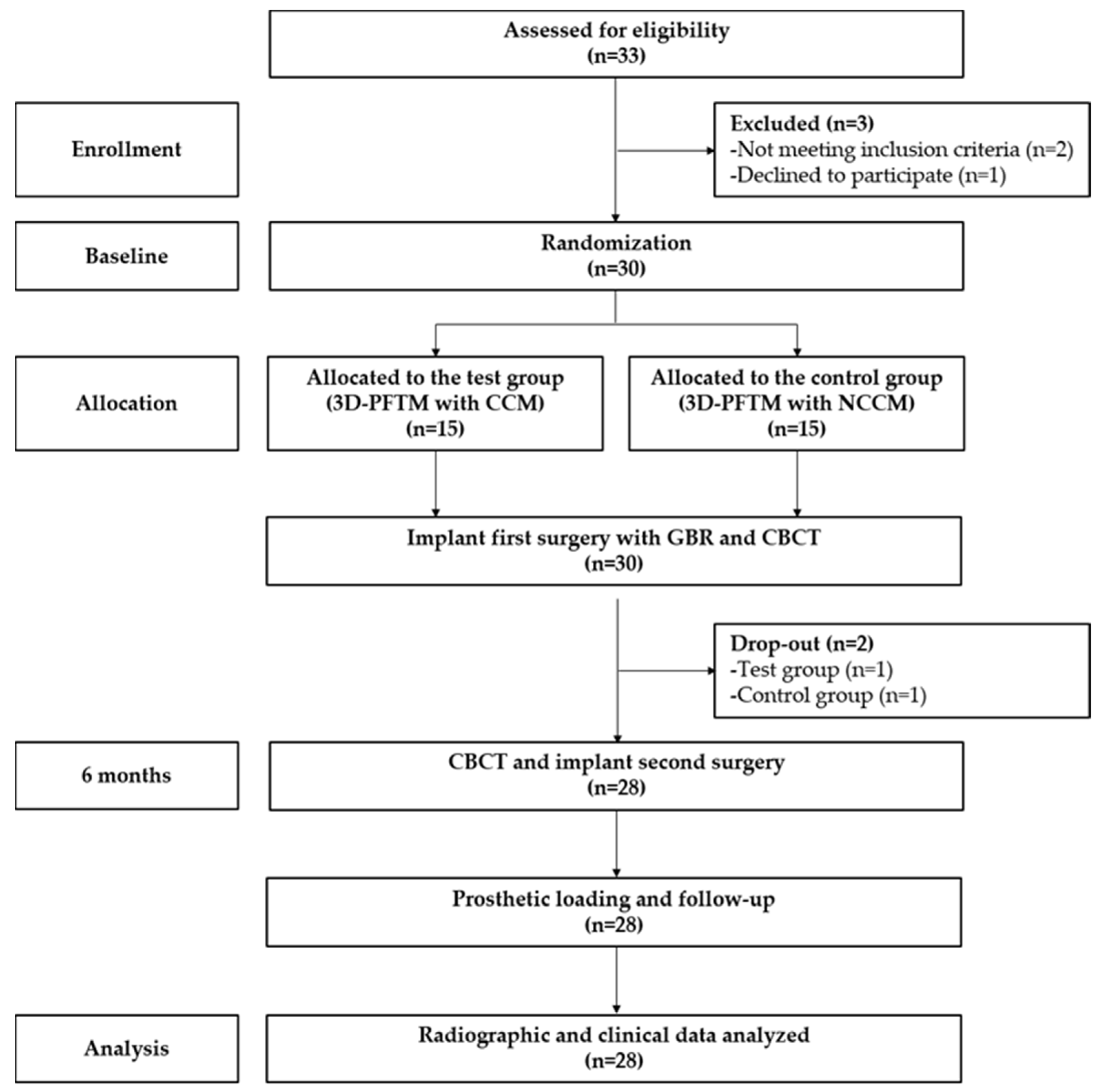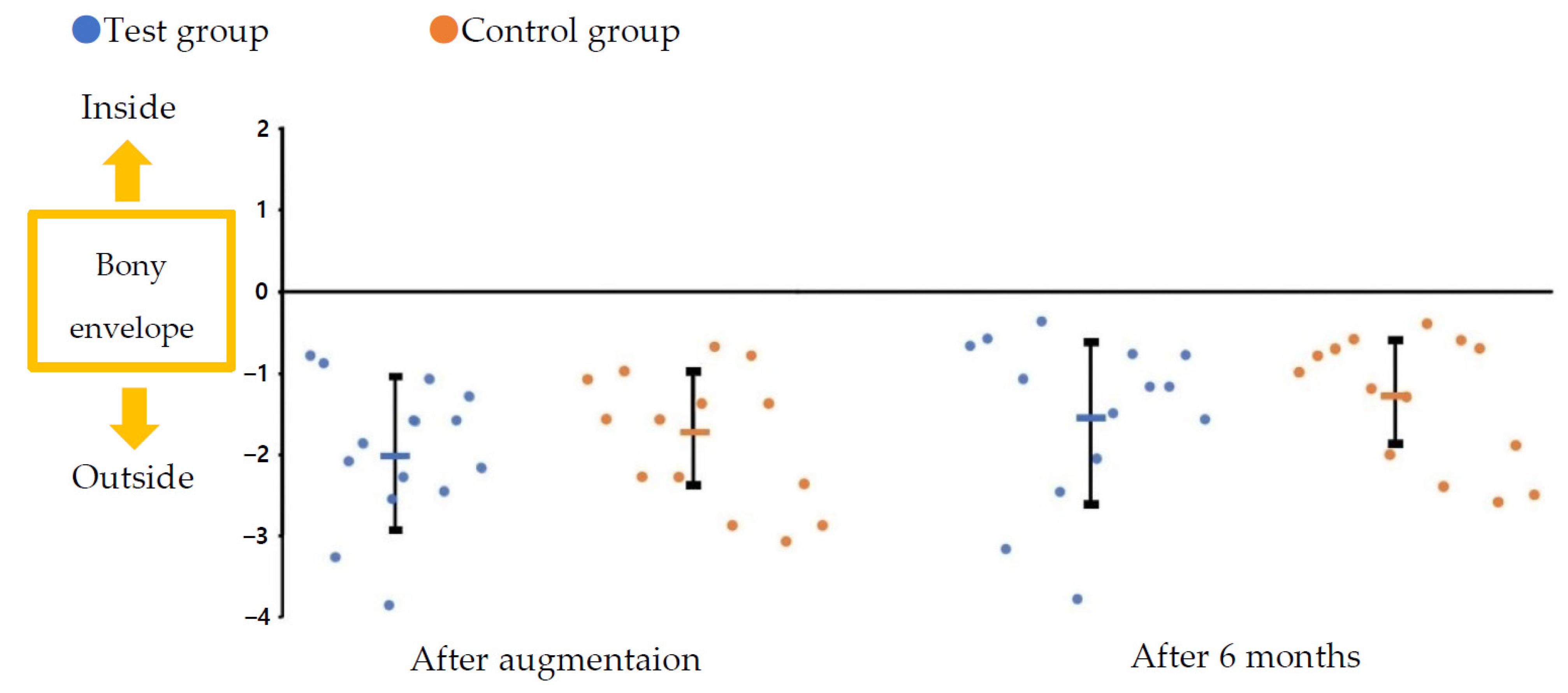Hard Tissue Volume Stability Effect beyond the Bony Envelope of a Three-Dimensional Preformed Titanium Mesh with Two Different Collagen Barrier Membranes on Peri-Implant Dehiscence Defects in the Anterior Maxilla: A Randomized Clinical Trial
Abstract
:1. Introduction
2. Materials and Methods
2.1. Study Design
2.2. Study Population
2.3. Randomization and Surgical Procedure
2.4. Results Analysis
2.4.1. Clinical Evaluation
2.4.2. Radiological Evaluation
2.5. Statistical Analysis
3. Results
3.1. Characteristics of Participants
3.2. Clinical Evaluation Results
3.3. Radiological Evaluation Results
4. Discussion
5. Conclusions
Author Contributions
Funding
Institutional Review Board Statement
Informed Consent Statement
Data Availability Statement
Acknowledgments
Conflicts of Interest
References
- Breine, U.; Brånemark, P.-I. Reconstruction of alveolar jaw bone. Scand. J. Plast. Reconstr. Surg. 1980, 14, 23–48. [Google Scholar] [CrossRef] [PubMed]
- Merheb, J.; Quirynen, M.; Teughels, W. Critical buccal bone dimensions along implants. Periodontology 2000 2014, 66, 97–105. [Google Scholar] [CrossRef] [PubMed]
- Bassetti, M.A.; Bassetti, R.G.; Bosshardt, D.D. The alveolar ridge splitting/expansion technique: A systematic review. Clin. Oral Implant. Res. 2016, 27, 310–324. [Google Scholar] [CrossRef] [PubMed]
- Hong, J.Y.; Baek, W.S.; Cha, J.K.; Lim, H.C.; Lee, J.S.; Jung, U.W. Long-term evaluation of sinus floor elevation using a modified lateral approach in the posterior maxilla. Clin. Oral Implant. Res. 2017, 28, 946–953. [Google Scholar] [CrossRef] [PubMed]
- Lorenzoni, M.; Pertl, C.; Polansky, R.; Wegscheider, W. Guided bone regeneration with barrier membranes—A clinical and radiographic follow-up study after 24 months. Clin. Oral Implant. Res. 1999, 10, 16–23. [Google Scholar] [CrossRef] [PubMed]
- Shet, U.K.; Cho, M.-S.; Hur, J.-W.; Oh, C.-J.; Chung, K.; Park, H.-J.; Kook, M.-S.; Jung, S.-G.; Oh, H.-K. Evaluation of augmented alveolar bone and dental implant after autogenous onlay block bone graft. J. Korean Dent. Assoc. 2012, 50, 329–338. [Google Scholar]
- Jung, G.-U.; Jeon, J.-Y.; Hwang, K.-G.; Park, C.-J. Preliminary evaluation of a three-dimensional, customized, and preformed titanium mesh in peri-implant alveolar bone regeneration. J. Korean Assoc. Oral Maxillofac. Surg. 2014, 40, 181. [Google Scholar] [CrossRef]
- Hämmerle, C.; Chen, S.T.; Wilson, T.G., Jr. Consensus statements and recommended clinical procedures regarding the placement of implants in extraction sockets. Int. J. Oral Maxillofac. Implant. 2004, 19, 26–28. [Google Scholar]
- Bogaerde, L.V. A proposal for the classification of bony defects adjacent to dental implants. Int. J. Periodontics Restor. Dent. 2004, 24, 264–271. [Google Scholar]
- Benic, G.I.; Thoma, D.S.; Muñoz, F.; Sanz Martin, I.; Jung, R.E.; Hämmerle, C.H. Guided bone regeneration of peri-implant defects with particulated and block xenogenic bone substitutes. Clin. Oral Implant. Res. 2016, 27, 567–576. [Google Scholar] [CrossRef]
- Zellin, G.; Gritli-Linde, A.; Linde, A. Healing of mandibular defects with different biodegradable and non-biodegradable membranes: An experimental study in rats. Biomaterials 1995, 16, 601–609. [Google Scholar] [CrossRef]
- Mir-Mari, J.; Wui, H.; Jung, R.E.; Hämmerle, C.H.; Benic, G.I. Influence of blinded wound closure on the volume stability of different GBR materials: An in vitro cone-beam computed tomographic examination. Clin. Oral Implant. Res. 2016, 27, 258–265. [Google Scholar] [CrossRef] [PubMed]
- Benic, G.I.; Thoma, D.S.; Jung, R.E.; Sanz-Martin, I.; Unger, S.; Cantalapiedra, A.; Hämmerle, C.H. Guided bone regeneration with particulate vs. block xenogenic bone substitutes: A pilot cone beam computed tomographic investigation. Clin. Oral Implant. Res. 2017, 28, e262–e270. [Google Scholar] [CrossRef] [PubMed]
- Jiang, X.; Zhang, Y.; Di, P.; Lin, Y. Hard tissue volume stability of guided bone regeneration during the healing stage in the anterior maxilla: A clinical and radiographic study. Clin. Implant Dent. Relat. Res. 2018, 20, 68–75. [Google Scholar] [CrossRef]
- Choi, I.-O.; Oh, J.-S.; Yu, S.-J.; Kim, B.-O.; Lee, W.-P. Retrospective Analysis of the Effect of Three-Dimensional Preformed Titanium Mesh on Peri-Implant Non-Contained Horizontal Defects in 100 Consecutive Cases. Appl. Sci. 2021, 11, 872. [Google Scholar] [CrossRef]
- Her, S.; Kang, T.; Fien, M.J. Titanium mesh as an alternative to a membrane for ridge augmentation. J. Oral Maxillofac. Surg. 2012, 70, 803–810. [Google Scholar] [CrossRef]
- Elgali, I.; Omar, O.; Dahlin, C.; Thomsen, P. Guided bone regeneration: Materials and biological mechanisms revisited. Eur. J. Oral Sci. 2017, 125, 315–337. [Google Scholar] [CrossRef]
- Rakhmatia, Y.D.; Ayukawa, Y.; Furuhashi, A.; Koyano, K. Current barrier membranes: Titanium mesh and other membranes for guided bone regeneration in dental applications. J. Prosthodont. Res. 2013, 57, 3–14. [Google Scholar] [CrossRef] [Green Version]
- Zita Gomes, R.; Paraud Freixas, A.; Han, C.-H.; Bechara, S.; Tawil, I. Alveolar ridge reconstruction with titanium meshes and simultaneous implant placement: A retrospective, multicenter clinical study. BioMed Res. Int. 2016, 2016, 5126838. [Google Scholar] [CrossRef]
- Corinaldesi, G.; Pieri, F.; Sapigni, L.; Marchetti, C. Evaluation of survival and success rates of dental implants placed at the time of or after alveolar ridge augmentation with an autogenous mandibular bone graft and titanium mesh: A 3-to 8-year retrospective study. Int. J. Oral Maxillofac. Implant. 2009, 24, 1119–1128. [Google Scholar]
- von Arx, T.; Hardt, N.; Wallkamm, B. The TIME technique: A new method for localized alveolar ridge augmentation prior to placement of dental implants. Int. J. Oral Maxillofac. Implant. 1996, 11, 387–394. [Google Scholar]
- Hartmann, A.; Seiler, M. Minimizing risk of customized titanium mesh exposures—A retrospective analysis. BMC Oral Health 2020, 20, 36. [Google Scholar] [CrossRef]
- Machtei, E.E. The effect of membrane exposure on the outcome of regenerative procedures in humans: A meta-analysis. J. Periodontol. 2001, 72, 512–516. [Google Scholar] [CrossRef] [PubMed]
- Simion, M.; Baldoni, M.; Rassi, P.; Zaffe, D. A comparative study of the effectiveness of e-PTFE membranes with and without early exposure during the healing period. Int. J. Periodontics Restor. Dent. 1994, 14, 166–180. [Google Scholar]
- Herzberg, R. Vertical guided bone regeneration for a single missing tooth span with titanium-reinforced d-PTFE membranes: Clinical considerations and observations of 10 consecutive cases with up to 36 months follow-up. Int. J. Periodontics Restor. Dent. 2017, 37, 893–899. [Google Scholar] [CrossRef] [PubMed] [Green Version]
- Funato, A.; Ishikawa, T.; Kitajima, H.; Yamada, M.; Moroi, H. A novel combined surgical approach to vertical alveolar ridge augmentation with titanium mesh, resorbable membrane, and rhPDGF-BB: A retrospective consecutive case series. Int. J. Periodontics Restor. Dent. 2013, 33, 437–445. [Google Scholar] [CrossRef] [PubMed] [Green Version]
- Degidi, M.; Scarano, A.; Piattelli, A. Regeneration of the alveolar crest using titanium micromesh with autologous bone and a resorbable membrane. J. Oral Implantol. 2003, 29, 86–90. [Google Scholar] [CrossRef] [Green Version]
- Salama, H.; Garber, D. Three-dimensional bone and soft tissue requirements for optimizing esthetic results in compromised cases with multiple implants. Int. J. Periodontics Restor. Dent. 2010, 30, 503–511. [Google Scholar]
- Lim, H.-C.; Lee, J.-S.; Choi, S.-H.; Jung, U.-W. The effect of overlaying titanium mesh with collagen membrane for ridge preservation. J. Periodontal Implant Sci. 2015, 45, 128. [Google Scholar] [CrossRef] [Green Version]
- Strietzel, F.P.; Khongkhunthian, P.; Khattiya, R.; Patchanee, P.; Reichart, P.A. Healing pattern of bone defects covered by different membrane types—A histologic study in the porcine mandible. J. Biomed. Mater. Res. Part B Appl. Biomater. Off. J. Soc. Biomater. Jpn. Soc. Biomater. Aust. Soc. Biomater. Korean Soc. Biomater. 2006, 78, 35–46. [Google Scholar] [CrossRef]
- Grunder, U.; Gracis, S.; Capelli, M. Influence of the 3-D bone-to-implant relationship on esthetics. Int. J. Periodontics Restor. Dent. 2005, 25, 113–119. [Google Scholar]
- Tarnow, D.; Cho, S.; Wallace, S. The effect of inter-implant distance on the height of inter-implant bone crest. J. Periodontol. 2000, 71, 546–549. [Google Scholar] [CrossRef] [Green Version]
- Simion, M.; Scarano, A.; Gionso, L.; Piattelli, A. Guided bone regeneration using resorbable and nonresorbable membranes: A comparative histologic study in humans. Int. J. Oral Maxillofac. Implant. 1996, 11, 735–742. [Google Scholar]
- Spray, J.R.; Black, C.G.; Morris, H.F.; Ochi, S. The influence of bone thickness on facial marginal bone response: Stage 1 placement through stage 2 uncovering. Ann. Periodontol. 2000, 5, 119–128. [Google Scholar] [CrossRef] [PubMed]
- Qahash, M.; Susin, C.; Polimeni, G.; Hall, J.; Wikesjö, U.M. Bone healing dynamics at buccal peri-implant sites. Clin. Oral Implant. Res. 2008, 19, 166–172. [Google Scholar] [CrossRef] [PubMed]
- Shin, S.I.; Herr, Y.; Kwon, Y.H.; Chung, J.H. Effect of a collagen membrane combined with a porous titanium membrane on exophytic new bone formation in a rabbit calvarial model. J. Periodontol. 2013, 84, 110–116. [Google Scholar] [CrossRef]
- Scarano, A.; Bernardi, S.; Rastelli, C.; Mortellaro, C.; Vittorini, P.; Falisi, G. Soft Tissue Augmentation by Means of Silicon Expanders Prior to Bone Volume Increase: A Case Series. J. Biol. Regul. Homeost. Agents 2019, 33, 77–84. [Google Scholar]





| 3D-PFTM + CCM (Test) | 3D-PFTM + NCCM (Control) | Total | |
|---|---|---|---|
| Ns | 14 | 14 | 28 |
| Ni | 14 | 14 | 28 |
| Mean age (range) | 48.2 ± 18.6 | 49.5 ± 19.5 | 48.9 ± 18.7 |
| (22–69) | (20–84) | (20≠84) | |
| Sex | |||
| Men, Ns (Ni) | 7 (7) | 7 (7) | 14 (14) |
| Women, Ns (Ni) | 7 (7) | 7 (7) | 14 (14) |
| Test | Control | Total | |
|---|---|---|---|
| Mesh exposure (N) | 1 | 1 | 2 |
| Mesh exposure rate (%) | 6.67 | 6.67 | 6.67 |
| ISQ (mean ± SD) | 73.77 ± 6.34 | 74.45 ± 7.53 | 74.11 ± 6.80 |
| Survival rate of implant (%) | 100 | 100 | 100 |
| Test (n = 14) | Control (n = 14) | Total (n = 28) | |
|---|---|---|---|
| BA (mean ± SD) (mm) | 2.91 ± 0.75 | 2.76 ± 0.62 | 2.83 ± 0.68 |
| p-value | 0.570 | ||
| HG (mean ± SD) (mm) | 2.44 ± 0.75 | 2.27 ± 0.63 | 2.35 ± 0.68 |
| p-value | 0.536 | ||
| BR (mean ± SD) (mm) | 0.47 ± 0.47 | 0.49 ± 0.40 | 0.48 ± 0.43 |
| p-value | 0.511 | ||
| HGR (mean ± SD) (%) | 84.25 ± 14.19 | 82.56 ± 13.04 | 83.41 ± 13.40 |
| p-value | 0.482 | ||
| Test (n = 14) | Control (n = 14) | Total (n = 28) | |
|---|---|---|---|
| After augmentation (mean ± SD) (mm) | −2.01 ± 0.89 | −1.82 ± 0.82 | −1.91 ± 0.84 |
| p-value | 0.571 | ||
| After 6 months (mean ± SD) (mm) | −1.54 ± 1.02 | −1.34 ± 0.79 | −1.44 ± 0.90 |
| p-value | 0.566 |
Publisher’s Note: MDPI stays neutral with regard to jurisdictional claims in published maps and institutional affiliations. |
© 2021 by the authors. Licensee MDPI, Basel, Switzerland. This article is an open access article distributed under the terms and conditions of the Creative Commons Attribution (CC BY) license (https://creativecommons.org/licenses/by/4.0/).
Share and Cite
Lee, S.-R.; Jang, T.-S.; Seo, C.-S.; Choi, I.-O.; Lee, W.-P. Hard Tissue Volume Stability Effect beyond the Bony Envelope of a Three-Dimensional Preformed Titanium Mesh with Two Different Collagen Barrier Membranes on Peri-Implant Dehiscence Defects in the Anterior Maxilla: A Randomized Clinical Trial. Materials 2021, 14, 5618. https://doi.org/10.3390/ma14195618
Lee S-R, Jang T-S, Seo C-S, Choi I-O, Lee W-P. Hard Tissue Volume Stability Effect beyond the Bony Envelope of a Three-Dimensional Preformed Titanium Mesh with Two Different Collagen Barrier Membranes on Peri-Implant Dehiscence Defects in the Anterior Maxilla: A Randomized Clinical Trial. Materials. 2021; 14(19):5618. https://doi.org/10.3390/ma14195618
Chicago/Turabian StyleLee, So-Ra, Tae-Sik Jang, Chang-Su Seo, In-Oh Choi, and Won-Pyo Lee. 2021. "Hard Tissue Volume Stability Effect beyond the Bony Envelope of a Three-Dimensional Preformed Titanium Mesh with Two Different Collagen Barrier Membranes on Peri-Implant Dehiscence Defects in the Anterior Maxilla: A Randomized Clinical Trial" Materials 14, no. 19: 5618. https://doi.org/10.3390/ma14195618
APA StyleLee, S.-R., Jang, T.-S., Seo, C.-S., Choi, I.-O., & Lee, W.-P. (2021). Hard Tissue Volume Stability Effect beyond the Bony Envelope of a Three-Dimensional Preformed Titanium Mesh with Two Different Collagen Barrier Membranes on Peri-Implant Dehiscence Defects in the Anterior Maxilla: A Randomized Clinical Trial. Materials, 14(19), 5618. https://doi.org/10.3390/ma14195618








